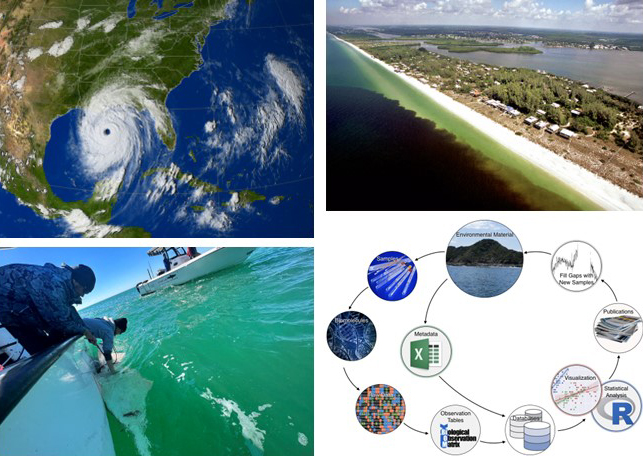Northern Gulf Institute Research Outcomes
April 23, 2025
The National Oceanic and Atmospheric Administration (NOAA) funds research at the Northern Gulf Institute (NGI) to address needs across the U.S. Gulf Coast region related to coastal hazards, climate impacts on regional ecosystems, ecosystem-based management, and data management systems. Scientists with NGI reported outcomes resulting from their research accomplishments for the 2024 fiscal year (July 1, 2023 to June 30, 2024). Below is a summary list of these outcomes:
Improved Forecasts
- Analysis of tropical cyclone forecasts by the National Hurricane Center improved with the use of more accurate estimates of wind speed above the ocean's surface during storms.
- Forecasts of extreme hydroclimate events (precipitation, drought, flood) by the Climate Prediction Center (CPC) improved by incorporating a newly demonstrated influence of El Nino-Southern Oscillation (ENSO) on these events.
- The 2024 Atlantic seasonal hurricane outlook made by the CPC improved with the use of more accurate uncertainty distributions in their models and user-oriented outlooks (e.g., energy sector).
- Predictions of storm intensification, surge, and wind radii by the Hurricane Analysis and Forecast System improved by incorporating a new Planetary Boundary Layer scheme that allows the system to better represent fast-changing boundary layer processes.
- Predictions by the Hurricane Research Division were supported with the use of verified observation-based estimates of drag coefficients for ocean surface turbulence under hurricanes, which also support the National Weather Service's ENSO forecasts.
- Assessments of storm surge model performance by the National Ocean Service improved with the use of visualizations of real-time comparisons of observations and model output for analysis.
Informed Fisheries Management
- Field survey data and analysis informed proposed changes to Florida's commercial shrimp trawl fishery for decreased sawfish bycatch mortality and informed federal stock assessments for scalloped/hammerhead sharks.
- Models with active learning algorithms – that improved model efficiency, performance, and reliability – improved automated fish detection and identification in video surveys and provided management with more timely and accurate fish population data; NOAA and academia are adopting these models.
- Sampling data and fish detection/descriptions acquired and processed with Electronic Monitoring technologies and Artificial Intelligence/Machine Learning algorithms inform stock assessments and strategies for protected marine wildlife.
- Continued storage of plankton samples allows for time-series analysis of phytoplankton community composition/biomass that can inform fisheries management.
Informed Ecosystem-Based Management
- Hypoxia management strategies are informed by improved analysis and forecasts that use newly developed models that recognize changing environments (e.g., warming ocean temperatures).
- Development of a red tide/hypoxia warning system that better represents ocean biogeochemical patterns should improve the accuracy of ocean forecast systems that scientists and resource managers use.
- Data on the Mississipi River runoff's influence on the ocean carbonate system was added to ocean acidification models, which in turn improved ocean-biogeochemical models that NOAA uses for ecosystem stressor scenarios.
- Improved hydrodynamic and salinity models that incorporate sea-level rise and climate data informs water quality decisions for south Florida.
- Coastal resource managers have updated data on river diversion impacts on marsh food webs; tidal wetlands migration under sea-level rise; and blue crab growth, use of turtle grass as habitat, nekton abundance and diversity.
- Temporal trends of the Gulf's biological carbon pump based on eDNA sediment analysis for biodiversity and variability are available for the marine science community's use.
- Evaluations of co-produced actionable science projects can inform resource managers' decisions on current and future science projects.
Enhanced Data Availability and Usability
- A bioinformatics platform for marine eDNA and microbiome that is being developed will enhance NOAA's omics data potential.
- Meteorological and oceanographic observations collected at sea are processed and uploaded to platforms for use by developers of satellite data products that forecast modelers use for weather predictions.
- Data management, stewardship, product development, and training provide support to NOAA's missions to share knowledge and information about climate, weather, ocean, and coasts with others (the National Center for Environmental Information's Information Services and Ocean-Ecosystem Products; the Ocean Exploration and Research Program); and to conserve and manage coastal and marine ecosystems and resources (Mesophotic and Deep Benthic Communities Restoration Projects; the Deep-Sea Coral Research and Technology Program).
The above outcomes resulted from research projects funded by NA21OAR4320190.
**********
The
Northern Gulf Institute is a NOAA Cooperative Institute with six academic institutions located across the U.S. Gulf Coast states that conducts research and outreach on the interconnections among Gulf ecosystems for informed decision making.
Article by
Nilde Maggie Dannreuther with the Northern Gulf Institute at Mississippi State University.
